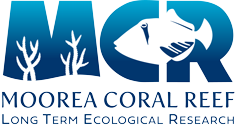Year:
2007
Authors:
Source:
Coral Reefs
Abstract:
Understanding the natural variability of photosynthetic pigment ranges and distributions in healthy corals is central to evaluating how useful these measurements are for assessing the health and bleaching status of endosymbiotic reef-building corals. This study examined the photosynthetic pigment variability in visibly healthy Porites lobata and Porites lutea corals from Kaneohe Bay, Hawaii and explored whether pigment variability was related to the genetic identity or phenotypic characteristics of the symbionts. Concentrations of the photosynthetic pigments chlorophyll a, peridinin, chlorophyll c(2) , diadinoxanthin, diatoxanthin, beta,beta-carotene and dinoxanthin were quantified using high-performance liquid chromatography (HPLC). Pigment concentrations were found to range 1.5-10 fold in colonies of each species at similar depths (0-2, 2-4, 10-15 and 19-21 m). Despite the high pigment variability, pigment ratios for each species were relatively conserved over the 0-21 m depth gradient. The genetic identity of the symbiont communities was examined for each colony using 18S nuclear ribosomal DNA (nrDNA) restriction fragment length polymorphisms. All colonies contained symbionts belonging to clade C. The density and phenotypic characteristics of the symbionts were explored using flow cytometry, and fluorescence and side scatter (cell size) properties revealed phenotypically distinct symbiont subpopulations in every colony. The symbiont subpopulations displayed pigment trends that may be driven by acclimatization to irradiance microenvironments within the host. These results highlight the biological complexity of healthy coral-symbiont associations and the need for future research on pigments and symbiont subpopulation dynamics.
Volume:
26
Issue:
2
Pages:
387-397
ISBN:
0722-4028
Publication Type:
Journal Article
ISI Number:
ISI:000247307100022



